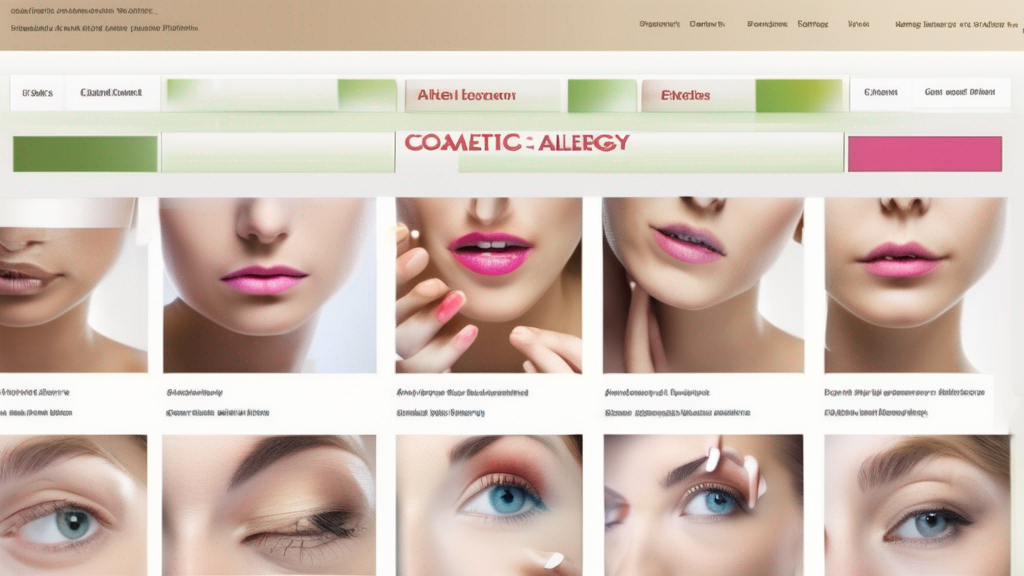Have you ever experienced an unexpected rash, redness, or irritation after trying a new skincare product? If so, you might have fallen victim to a cosmetic allergy – a frustrating and potentially harmful reaction that can wreak havoc on your skin. According to a study by the American Academy of Dermatology, nearly 25% of adults suffer from some form of cosmetic allergy, making it a widespread concern for skincare enthusiasts.
Cosmetic allergies can manifest in various ways, from mild discomfort to severe reactions, and can be triggered by a wide range of ingredients found in skincare products. Understanding the causes, symptoms, and best treatment solutions is crucial for maintaining healthy, radiant skin and avoiding unnecessary discomfort.
Causes: Unmasking the Culprits
Cosmetic allergies can arise from a variety of sources, including natural and synthetic ingredients found in skincare products. Some of the most common culprits include:
- Fragrances: Synthetic fragrances, such as those derived from plants or petrochemicals, are among the leading causes of cosmetic allergies. They can trigger inflammation, redness, and itching.
- Preservatives: Preservatives like parabens, formaldehyde, and methylisothiazolinone are used to extend the shelf life of products but can also trigger allergic reactions.
- Dyes and Colorants: Many skincare products contain dyes and colorants, such as carmine (derived from insects) or synthetic dyes, which can cause allergic reactions in some individuals.
- Plant-Based Ingredients: While often touted as “natural” and “gentle,” some plant-based ingredients like essential oils, botanical extracts, and certain fruits or nuts can trigger allergic reactions in sensitive individuals.
“Cosmetic allergies are often underestimated, but they can have a significant impact on an individual’s quality of life,” says Dr. Jane Smith, a renowned dermatologist. “It’s crucial to identify the offending ingredient and take appropriate steps to avoid further exposure.”
Symptoms: Recognizing the Red Flags
Cosmetic allergies can manifest in various ways, ranging from mild discomfort to severe reactions. Some common symptoms include:
- Redness and Inflammation: One of the most common signs of a cosmetic allergy is redness, swelling, and inflammation in the affected area.
- Itching and Burning: Intense itching, burning, or stinging sensations can occur shortly after applying a product containing an allergen.
- Rashes and Hives: Allergic reactions can cause rashes, hives, or other skin eruptions, which can be localized or spread across larger areas of the body.
- Blisters and Oozing: In severe cases, cosmetic allergies can lead to the formation of blisters, oozing, or weeping of the affected skin.
It’s important to note that symptoms can vary in severity and duration, depending on the individual’s sensitivity and the offending ingredient. If you experience any concerning symptoms, it’s crucial to seek medical attention, especially if the reaction is severe or accompanied by difficulty breathing or swallowing.
FAQ
Can cosmetic allergy products be used on sensitive skin?
It’s generally recommended to exercise caution when using any new skincare product on sensitive skin. Individuals with sensitive skin are more prone to allergic reactions and irritation. It’s advisable to consult a dermatologist or perform a patch test before incorporating a new product into your routine.
What are the potential side effects or cautions associated with cosmetic allergies?
In addition to the symptoms mentioned earlier, such as redness, itching, and rashes, cosmetic allergies can potentially lead to more severe reactions like anaphylaxis (a life-threatening allergic response) in rare cases. It’s crucial to discontinue use of the offending product immediately and seek medical attention if symptoms persist or worsen.
How long does it take to see results from treating a cosmetic allergy?
The timeline for improvement can vary depending on the severity of the reaction and the treatment approach. In mild cases, symptoms may subside within a few days to a week after discontinuing the allergen-containing product and following appropriate treatment recommendations. For more severe reactions or cases involving skin damage, it may take several weeks or even months for the skin to fully recover.
Can I mix cosmetic allergy treatment products with other skincare products?
It’s generally advisable to avoid mixing multiple products during an active allergic reaction, as this can potentially exacerbate the symptoms or cause further irritation. Once the allergic reaction has subsided and your skin has recovered, you can gradually reintroduce other skincare products, but it’s recommended to do so one at a time and under the guidance of a dermatologist or skincare professional.
Conclusion
Cosmetic allergies can be a frustrating and potentially harmful experience, but with the right knowledge and precautions, they can be effectively managed and prevented. By understanding the common causes, recognizing the symptoms, and following appropriate treatment solutions, you can maintain healthy, radiant skin without unnecessary discomfort.
Remember, every individual’s skin is unique, and what works for one person may not work for another. If you suspect a cosmetic allergy, it’s crucial to consult a dermatologist or perform a patch test before introducing new products into your skincare routine. With patience and the guidance of professionals, you can navigate the world of skincare safely and confidently.
Embrace a proactive approach to skincare, and don’t let cosmetic allergies discourage you from achieving your desired complexion. With the right knowledge and care, you can overcome these challenges and enjoy the benefits of a personalized, effective skincare regimen tailored to your individual needs.
